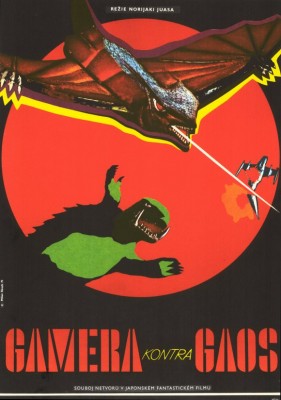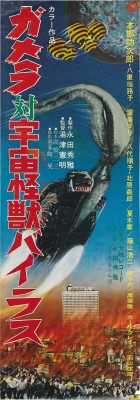| Reviews & Columns |
|
Reviews DVD TV on DVD Blu-ray 4K UHD International DVDs In Theaters Reviews by Studio Video Games Features Collector Series DVDs Easter Egg Database Interviews DVD Talk Radio Feature Articles Columns Anime Talk DVD Savant Horror DVDs The M.O.D. Squad Art House HD Talk Silent DVD
|
DVD Talk Forum |
|
|
| Resources |
|
DVD Price Search Customer Service #'s RCE Info Links |
|
Columns
|
|
|
Gamera Double Feature - Gamera Vs. Gyaos / Gamera Vs. Viras
As Daiei struggled to maintain its solvency the Gamera movies got cheaper and cheaper, resorting to cheats like long montages of stock scenes from the earlier movies - a cost-cutting move that turns up in almost every sequel. And yet - at least for a time - despite the downward spiraling budgets the movies actually got better and better, peaking with Gamera vs. Guiron (1969), which is like an imaginative eight-year-old Japanese boy's dream come to Fujicolored life.
Shout! Factory's DVD crams both movies onto a single-sided, dual-layered DVD with Japanese and English language options and subtitles, but the excellent 16:9 enhanced transfers don't suffer too badly. At the bargain SRP of just $19.93, it's a steal compared to the similarly excellent English-subtitled Region 2 DVDs from Japan, which sold for more than twice that for a single film.
Yuasa and Takahashi's transformation of the kaiju eiga ("giant monster movie") genre took a few films to crystallize. The first Gamera movie, Gamera - The Giant Monster (1965) pretty much strolled down Godzilla's well-trodden path, awkwardly inserting a peculiar, delusional little boy into the proceedings. When that film became an unexpected hit, Daiei pulled out all the stops for the sequel, Gamera vs. Barugon (1966), even demoting series director Yuasa so a more "important" A-picture director (Shigeo Tanaka) could helm this relatively lavish production, intent on appealing to the same mainstream demographics that had flocked to Toho's enormously popular Mothra (1961) and King Kong vs. Godzilla (1962). (Gamera vs. Barugon has story and character elements common with both those films.)
Apparently Gamera vs. Barugon didn't set the world on fire, because starting with the less expensive, less important Gamera vs. Gyaos (Daikaiju kuchusen - Gamera tai Gyaosu, or "Giant Monster Midair Battle - Gamera vs. Gyaos," 1966), Daiei pretty much left Yuasa and Takahashi to their own devices.
Gamera vs. Gyaos, first shown in America (via AIP-TV) under the title Return of the Giant Monsters, is set near Mt. Fuji where a battle of wills rages between a construction firm (its foreman, Shiro Tsutsumi, is played by top-billed Kojiro Hongo, an A-list Daiei contract player) building a highway, and local villagers jockeying for a king's ransom in exchange for their precious land. None of this is terribly important, however, as the pivotal human character in the story is Eiichi (Naoyuki Abe), the grandson of local village elder Kanamura (Kichijiro Ueda, a prestigious character actor in most of Akira Kurosawa's best films).
Nearby, a United Nations survey team, aboard a large helicopter, watch helplessly as a sonic beam (resembling a thick laser) neatly slices their aircraft in two. Later, an overly ambitious reporter (Shin Minatsu) and Eiichi investigate, only to find the source of the beam: a bat-like giant monster Eiichi names Gyaos. The monster eats the reporter, but Gamera shows up to save the little boy. The monsters head for Nagoya, Japan's third-biggest city (Gamera having already pummeled Tokyo and Osaka), while the Japanese Self-Defense Force, Eiichi, and foreman Tsutsumi try to figure out how to stop the destructive Gyaos, as the construction firm and the villagers continue squabbling in the background.
Kaiju eiga fans generally regard Gamera vs. Gyaos as the best of the original Gamera films, probably because it strikes a pretty fair balance between epic scenes of destruction and the material more emphatically geared to children. When the Gamera series was resurrected in the mid-1990s, the first film to be made, the shockingly good Gamera: Guardian of the Universe (Gamera - Daikaiju kuchu kessen, 1995), was a faithful remake of this film, though to Noriaki Yuasa's dismay, the child-perspective elements were almost entirely jettisoned.
For years Gamera vs. Gyaos, along with the rest of the series, has been difficult to properly assess and for a variety of reasons: the original widescreen Japanese versions weren't available, the later "Sandy Frank" versions, featuring awful English-dubbing, all but ruined the viewing experience. But worst was the tendency of American reviewers (this one included) to stack up these middle- and late-period Gamera movies against other kaiju eiga targeting an entirely different demographic. Additionally, the function of children in Japanese genre films and other cultural differences further muddied western understanding.
Looking at it now, Gamera vs. Gyaos still has trouble deciding what it wants to be, but for its intended audience - teenagers and (especially) children, little boys particularly - the film delivers an orgy of excitement. In this film more than any of the others director Yuasa, a rotund, child-like-innocent himself, seems to have modeled Eiichi after himself, personally. (Uncannily, Eiichi is also a dead-ringer for dim-bulb accountant Kevin on The Office.)
The film is full of ideas that, from a more realistic giant monster movie perspective (as seen in the earliest kaiju eiga and American films like The Beast from 20,000 Fathoms and Them!) are totally absurd. And yet, from the perspective of an eight-year-old boy, make perfect sense. One example: to trap Gyaos, Eiichi and the JSDF come up with a plan that involves putting a huge bowl of blood atop a hotel with a revolving restaurant, the idea being that while Gyaos is slurping up the blood, the rotating restaurant he's standing atop will make the monster dizzy. Sure, why not?
The film's dark but outrageously unrealistic humor further supports Yuasa-Takahashi's child-like perspective. In addition to the helicopter, in one scene Gyaos uses his deadly sonic beam to slice a car full of reporters in two as well, the bisected vehicle continuing to drive down the highway as the reporters gape in awe. It's like something out of Laurel & Hardy. This reviewer never much cared for Gyaos itself: the costume is too stiff and inexpressive (trap-door mouth, emphatically glowering - and glowing! - eyes, etc.) but the special effects are impressive by '60s genre standards. One or two matte shots are so good only sharp-eyed viewers will notice they are visual effects.
Even better though is Gamera vs. Viras (Gamera tai uchu kaiju Bairasu, or "Gamera vs. the Space Monster Viras," 1968), remembered by older generations as Destroy All Planets, its AIP-TV title. Worth noting: Earlier this summer Retromedia released Destroy All Planets 2010, the presumed public domain variation of the film, derived from AIP's 16mm television syndication version. While that release is generally poor it does include an audio commentary track featuring Carl Craig, the film's American co-star.
Masao (Toru Takatsuka) and his American (though Japanese-speaking) friend Jim (Craig) are Boy Scouts who with Scout Master Mr. Shimada (Kojiro Hongo again) are on a field trip to a seaside aquarium. There the mildly mischievous but clever boys eventually get to operate an experimental two-man submarine, liability insurance be damned. Underwater the boys and their sub encounter Gamera but evil aliens, in a spacecraft resembling a quintet of stripped ping-pong balls connected together with straws, traps Gamera in a force field and kidnaps the boys.
As the boys try to escape, encountering humanoid aliens (with glowing eyes and dressed like anesthesiologists) and a squid-like creature apparently also held captive, Gamera is blackmailed into destroying Japan lest the boys be harmed.
Giving Masao an American pal was a conscious effort to make the film more appealing to Western audiences - Yuasa said AIP itself had requested it - and it's a good idea that works wonderfully well, so much so that the following year's entry, Gamera vs. Guiron, offered a similar Japanese boy-American boy arrangement, giving the Japanese boy a little sister as well, and further de-emphasizing the adults to the point where the series resembled Charles M. Schulz's Peanuts more than anything emanating from Toho. The kids here really act like best pals, and unlike the first few Gamera films, where the children awkwardly delivered adult-scripted dialogue, here they come off as entirely naturalistic and Yuasa directs them extremely well throughout.
This was the first entry to completely rid itself of the more adult conventions of the genre; from beginning to end, it's a movie about kids with the storytelling logic of a highly imaginative child (the adventure with the submarine, trying to escape the alien's spaceship, etc.). The film is downright surreal and nightmarish/dream-like much of the time; the best example of this is when the squid creature decapitates the heads of its alien crew to form a single, colossal squid monster, Viras.
The reduced budget forced some obvious cost cutting. Though only 81 minutes in length, the film stops dead in its tracks for 11 solid minutes (from 21:50 to 32:35) for highlights from the previous three films, as the aliens scan Gamera's "memory waves." (Apparently another cut of the film uses even more stock footage, 19 minutes worth.) Since it's all monster-action footage, Japanese audiences in 1968 seeing these movies once a year probably weren't too disappointed, but when the series is viewed on DVD back-to-back this glut of stock scenes is a bit much.
Video & Audio
Filmed in Daiei's CinemaScope-like Daieiscope process, Gamera vs. Gyaos and Gamera vs. Viras look just wonderful in their 16:9 enhanced widescreen transfers, transfers comparable to the superlative Tokuma/Toshiba DVDs from Japan. (The DVDs had English subtitles while Kadokawa's recent line of Blu-ray discs, alas, do not. These, however, do look absolutely spectacular.) The English subtitles are generally fine, though some of the translations are weirdly anachronistic, such as one line of dialogue translated as, "Don't wuss out, man!"
Besides offering the films in their original (mono) Japanese with English subtitles, Shout! apparently worked out an arrangement with MGM, owners of the AIP-TV English-dubbed audio tracks. MGM no longer has rights to the films, but generously provided the AIP soundtracks that are infinitely superior to Daiei's "international" English ones. Gamera vs. Gyaos includes this "international" track (with poor audio) in addition to the AIP-TV version.
Extra Features
Shout! has scaled back in this regard. There are no booklets, no audio commentaries, interviews or trailers this time out, though the disc does include extensive publicity galleries for both films; however, the image size is rather small throughout. The gallery confirms the latter film had a limited theatrical release in Japanese-American theaters under the title Gamera vs. Bairus (on a double-bill with The Battle of the Spooks, presumably Spook Warfare).
Parting Thoughts
If viewed with the understanding that these films were targeting an audience of enthusiastic, monster-loving children, this double-bill of beautifully transferred monster extravaganzas are just the ticket for a rainy Saturday afternoon. Highly Recommended.
Stuart Galbraith IV's latest audio commentary, for AnimEigo's Musashi Miyamoto DVD boxed set, is on sale now.
|
| Popular Reviews |
| Sponsored Links |
|
|
| Sponsored Links |
|
|
| Release List | Reviews | Shop | Newsletter | Forum | DVD Giveaways | Blu-Ray | Advertise |
|
Copyright 2024 DVDTalk.com All Rights Reserved. Legal Info, Privacy Policy, Terms of Use,
Manage Preferences,
Your Privacy Choices | |||||||















